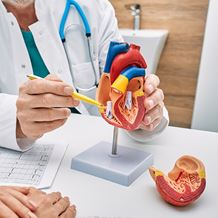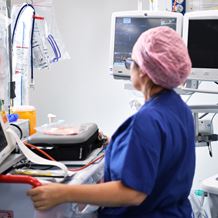What is a heart biopsy?
A heart biopsy, also referred to as a cardiac biopsy or myocardial biopsy, is a minimally invasive procedure that removes small pieces of your heart muscle tissue for further examination. It is performed using a special technique known as cardiac catheterisation. Doctors use a heart biopsy to look for cell changes in the heart that may indicate heart damage or a heart problem.
What does it do?
A heart biopsy provides your doctor with extra information about your heart that wouldn’t be available through another test or procedure. It can help your doctor understand more about what may be causing your heart condition and how well your heart is responding to treatment. The minimally invasive technique means that patients experience a shorter time in hospital and a quicker recovery period. It is generally considered a low-risk procedure.
How does it work?
Some heart conditions cannot be detected from imaging alone. A heart biopsy is a minimally invasive procedure that looks specifically at cell changes in your heart. Using a special technique known as cardiac catheterisation, a small amount of heart tissue is collected and removed for testing. The results will accurately inform your doctor if there is any damage or disease in your heart muscle.
Why is it performed?
Your doctor may recommend a heart biopsy if there is a potential problem with your heart. It can be used in conjunction with other tests and procedures to confirm a diagnosis and looks specifically for problems in the heart muscle. It can help to diagnose a range of conditions including:
- Cardiomyopathy – a heart muscle disease that affects how well the heart pumps blood around the body
- Myocarditis – heart tissue inflammation
- Heart failure – where the heart is not working effectively
- Heart cancer – where tumours have formed in the heart
- Heart transplant rejection – where tissue damage has been caused by the immune system
Procedure
After a local anaesthetic is administered, a small flexible catheter is gently inserted into a vein in the neck, arm or groin. The catheter is guided through the body until it reaches the heart. The pincer mechanism (bioptome) used to remove the heart tissue is then guided along through the catheter using a special type of X-ray machine. Once it has reached the location, a small amount of heart tissue is removed and sent for examination. The procedure is painless and likely to take under one hour.
Recovery
Heart biopsy is a quick and painless operation, with most patients returning to a normal level of activity the following day. There may be some slight bruising around the insertion site, and you will be advised to avoid any heavy lifting for 24 hours. Your doctor will talk to you about the results of the heart biopsy once they have returned.
What's next?
If you have been experiencing heart-related symptoms, book an appointment with our cardiac services specialist today.
Our specialists in Cardiac Services
View all specialists






